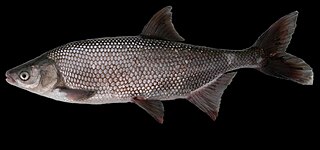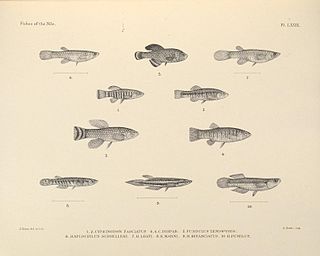
The hitch is a cyprinid fish endemic to central California, and was once very common. The name is derived from the Pomoan word for this species.
Garra nana is a ray-finned fish species in the family Cyprinidae. It is found in Israel, Jordan and Syria. Its natural habitats are freshwater rivers, lakes and ponds of the Barada and Jordan River drainage basins, as well as the Kishon River. This bottom-dwelling fish is often overlooked, as it is small and prefers to hide among stones and water plants. It is an omnivore which feeds on aufwuchs. The species was previously placed in the genus Hemigrammocapoeta. It reaches up to 12 cm (4.7 in) in total length.
The Darling River hardyhead is a species of fish in the family Atherinidae endemic to Australia. The species name amniculus is from the Latin meaning a small creek or stream, in reference to the habitat where these fish are often found.

Craterocephalus is a genus of small and slender brackish or freshwater silversides from Australia and New Guinea. It is the most diverse genus in the family Atherinidae, containing 25 of the 71 species.
The Dalhousie hardyhead is a species of silverside in the family Atherinidae. It is endemic to the warm waters of Dalhousie Springs in the Lake Eyre basin, Australia, along with the similar Craterocephalus gloveri. It inhabits shady areas in tropical freshwater streams at 20-39 °C, but has been recorded at 41.8 °C. Its food consists of gastropods, aquatic plants, green filamentous algae, detritus and small invertebrates; food is mainly taken from the substrate.

The Murray hardyhead is a species of fish in the family Atherinidae endemic to inland parts of southeastern Australia. The fish is an omnivore, feeding on small crustaceans, aquatic insects and algae.
Glover's hardyhead is a species of fish in the family Atherinidae endemic to Dalhousie Springs in the Lake Eyre basin, Australia. The fish has a high thermal tolerance and inhabits warm, freshwater spring-fed pools and channels. It is listed as vulnerable on the IUCN Red List. The specific name honours John Glover (1935–1992) who was the Curator of Fishes at the South Australian Museum.
The Drysdale hardyhead is a species of fish in the family Atherinidae endemic to the Drysdale River in the Kimberley region of Australia. It is listed as near threatened on the IUCN Red List and rare under the Australian EPBC Act 1999. The specific name honours Ivantsoff's wife, Helena.
Kailola's hardyhead is a species of fish in the family Atherinidae endemic to Papua New Guinea. It reaches a maximum length of 6 cm. It inhabits shallow, clear creeks with gravel substrate. This species was described by Walter Ivantsoff, Lucy Crowley and Gerald R. Allen in 1987 with a type locality of a still backwater of Foasi Creek 3 kilometers west of Safia airstrip in Papua New Guinea. The specific name honours the Patricia J. Kailola, for her contribution to the knowledge of the ichthyology of Papua New Guinea.
The Kutubu hardyhead is a species of fish in the family Atherinidae. It is endemic to Lake Kutubu and its outlet, the Soro River, in the Kikori River system, Papua New Guinea. Within its range this species is extremely abundant and large schools may be formed in the shallow margins of the lake, both in open water and among the aquatic vegetation. This species was described by Ethelwynn Trewavas in 1940.
Craterocephalus lentiginosus, the freckled hardyhead is a species of fish in the family Atherinidae endemic to the Kimberley region in the northwest of Australia. It is also called the Prince Regent hardyhead.
The Magela hardyhead or Mariana's Hardyhead, is a species of fish in the family Atherinidae endemic to Australia. It has a very restricted distribution, only found in the Alligator Rivers region of the Northern Territory where it inhabits shallow and fast-flowing freshwater creeks. The fish has a high thermal tolerance, like some other species in the genus Craterocephalus, and may tolerate water temperatures up to 39.5º. The specific name honours Walter Ivantsoff's daughter, Marian.
The Pima hardyhead is a species of silverside in the family Atherinidae which is endemic to Papua New Guinea. This species was described in 1991 by Walter Ivantsoff, Lucy Crowley and Gerald R. Allen with the type locality given as the junction of Pima and Tua rivers. It has not been recorded since the collection of the types.
Synodontis centralis is a species of upside-down catfish that is endemic to the Democratic Republic of the Congo where it occurs in the middle Congo Basin. It was first described by Max Poll in 1971. The original specimens were obtained in Ndwa village, Kunungu, Zaire. The species name centralis refers to its habitat in the central Congo Basin.
Hardyhead refers to a number of species of fish in the family Atherinidae, including:

The Arabian toothcarp is a species of killifish belonging to the family Cyprinodontidae. It can be found from the shores of the Red Sea south to Ethiopia, the Gulf of Aden, the Arabian Sea and along the Persian Gulf east to Pakistan and India. It is also found in the Suez Canal, the northern coast of the Sinai Peninsula, and in one location on the palestine coast. There are two recognized subspecies: A. d. dispar found throughout the range, and A. d. richardsoni, the Dead Sea toothcarp endemic to the Dead Sea.

The Pacific blue-eye is a species of fish in the subfamily Pseudomugilinae native to eastern Australia. Described by Austrian naturalist Rudolf Kner in 1866, it comprises two subspecies that have been regarded as separate species in the past and may be once again with further study. It is a common fish of rivers and estuaries along the eastern seaboard from Cape York in North Queensland to southern New South Wales, the Burdekin Gap in central-north Queensland dividing the ranges of the two subspecies.

Craterocephalus marjoriae, commonly known as Marjorie's hardyhead or silverstreak hardyhead, is a species of fish in the family Atherinidae that is native to eastern Australia, namely central Queensland to northeastern New South Wales. Here it inhabits clear flowing streams and it is common among the vegetation in their margins. It prefers shallow water over streambeds consisting of sand or gravel. It forms shoals. They spawn on multiple occasions between September and January, although this peaks earlier in the season. They form pairs for spawning, the eggs being deposited on aquatic vegetation to which they adhere. The eggs are large measuring 1.15-1.25 mm in diameter and have adhesive filaments. The eggs hatch after around a week and the larvae measure about 5.7 mm standard length. Their diet consist mostly of aquatic insects and their larvae, small crustaceans, algae and fish eggs. This species was described by Gilbert P. Whitley in 1948 with the type locality given as Eidsvold on the Burnett River in Queensland. Whitley may have named this species in honour of his sister Marjorie Frewer.

Hemichromis letourneuxi is a species of cichlid which is native to West Africa and is popular in the aquarium hobby and it has been introduced to the Caribbean and the south-east United States where it is invasive.

Craterocephalus eyresii, the Lake Eyre hardyhead, is a species of freshwater silverside from the family Atherinidae which is endemic to the Lake Eyre basin in Australia.







